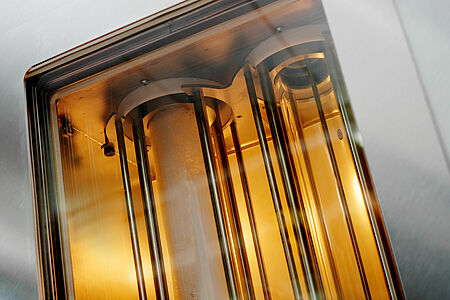Foam Tester FOA
Test Foaming Properties of Liquids
The Foam Tester FOA enables the investigation of foams with regard to foam production, stability and foam decomposition.
Based on the ASTM D892 the Foam Tester FOA extends the measuring possibilities to increased pressure ranges with only insignificant changes in design. Even aqueous liquids can now be tested under pressure for their foaming behaviour at elevated, previously inaccessible temperatures of more than +100 °C.
All important characteristics of the Foam Tester
Test foam behaviour at various conditions

The Foam Tester FOA can be equipped with one or two measuring cells. This enables the test of foams at variable conditions. The foam production (foaming), the foam stability and also the foam decomposition can be tested.
The foam is produced by injecting nitrogen or compressed air through a nozzle. The gas enters the sample through a diffuser, so it is very finely distributed. This results in very homogeneous foam formation. The gas is also brought to test temperature in a preheating column.
Everything under control with the Foam Tester
The Foam Tester enables extensive control of the process parameters:
- The gas flow is controlled by an electronic flow controller - Each cell is equipped with an individual controller.
- The cell pressure is regulated by a spring-supported overflow valve - Each cell is equipped with an individual regulator.
- Varoius diffusor sizes to adjust the bubble size.
- Gas flow and pressure are monitored and recorded permanently by software.
- The temperature is identical for both cells.
Simple handling by pneumatic lift
Integrated in the Foam Tester FOA is a pneumatic lift which moves the cells upwards out of the instrument. This makes the cells easy and safe to remove and mount.
Different measurement methods for foam
Carry-over Test
In a carry-over test the produced foam is discharged and collected outside the test cell. The collected mass is measured by a laboratory balance.
The foam is produced and discharged depending on the temperature, gas flow rate, pressure and pore size of the diffusor.
The ratio between total mass of discharged foam and liquid used with and without foaming agent gives the effectiveness for the foaming agent.
For tests at higher temperatures the foam can be cooled while it is discharged.
Foam Stability
To test foam stability a specific amount of foam is produced in the test cell in relation to temperature, gas flow rate, pressure and diffusor pore size. The foam is decomposing simultaneously so an equillibrium between production and decomposition can be achieved. The resulting height of the foam in the test cell can be measured directly on the scale imprinted on the test cells.
Additives which effects the foam stability can be injected during the test.
The test procedure
The test procedure depends in detail on the test to be performed (carry-over, stability, collapse test). In general, the test cell is filled with the sample in a certain quantity, closed, inserted into the Foam Tester and tempered in the oven. The gas flow and the test pressure are adjusted and when the test temperature is reached the foaming of the sample is started.
In a carry-over test, foaming is continued until no more foam discharges. The total mass of the foam is the indicator of the effectiveness of the foaming agent - the more liquid is discharged as foam compared to the blind test, the more effective the foaming agent is.
In a stability test foam is only produced up to a certain height in the test cell, there is no discharge of foam. The resulting height is influenced by the additives to be tested, which are evaluated in comparison to the blank test or changed test parameters.
For a collapse test foam is produced up to a certain height in the test cell. Then the gas flow is stopped and the behaviour of the foam during decomposition is evaluated. Additives that influence decomposition are evaluated against the blank test or against changed test parameters.
Related products
back to product overview








